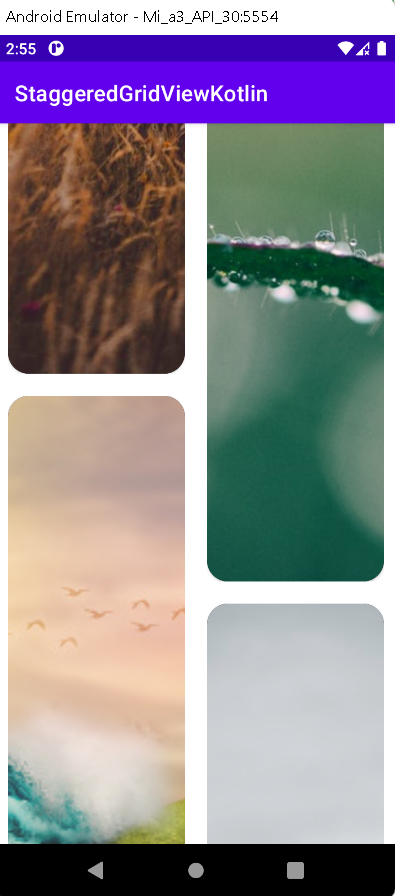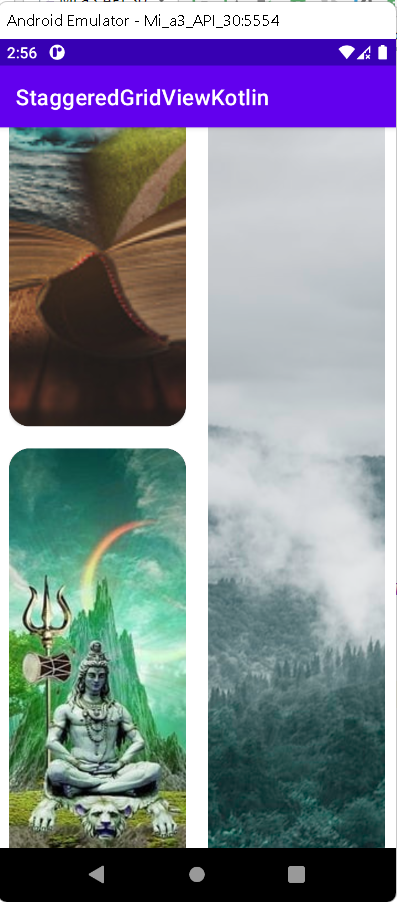Implement StaggeredGridView in Android Using Kotlin
Android staggered Gridview with kotlin
Last updated Jan 09, 2022 In this android example tutorial, we will see how to implement and use Staggered Gridview on RecyclerView in Android using Kotlin.
Recyclerview: RecyclerView is a more advanced and adaptable version of the listview and gridview. It's a container for presenting
large amounts of data sets in a way that allows them to be browsed quickly while limiting the number of views. It has the ability to reuse its views.
What is StaggeredGridLayout?
StaggeredGridView:StaggeredGridLayout is a LayoutManager in the android studio similar to GridView, but in StaggeredGridLayout each grid has its own height and width.
Implementation of StaggeredGridView on Recyclerview:
Step 1. Create a new Project in android studio.
|
Go to File > New > New Project > Empty Activity > Next > Enter Name > Select Language Kotlin > Finish.
|
Step 2. Add the RecyclerView dependency to build.gradle(app).
|
implementation 'androidx.recyclerview:recyclerview:1.2.1'
|
Step 3. Go to activity_main.xml file and add the following xml code:
|
<LinearLayout xmlns:android="http://schemas.android.com/apk/res/android"
xmlns:tools="http://schemas.android.com/tools"
android:layout_width="match_parent"
android:layout_height="match_parent"
android:orientation="vertical"
tools:context=".MainActivity">
<androidx.recyclerview.widget.RecyclerView
android:id="@+id/recyclerView"
android:layout_width="wrap_content"
android:layout_height="wrap_content" />
</LinearLayout>
|
Step 4. Create a new layout resource file and add the following code
|
app > res > layout > new > layout resource file > enter name (layout_items) > ok
|
Code:
|
<?xml version="1.0" encoding="utf-8"?>
<LinearLayout xmlns:android="http://schemas.android.com/apk/res/android"
android:layout_width="match_parent"
android:layout_height="wrap_content"
xmlns:app="http://schemas.android.com/apk/res-auto"
android:orientation="vertical"
android:padding="10dp">
<androidx.cardview.widget.CardView
android:layout_width="wrap_content"
android:layout_height="wrap_content"
app:cardCornerRadius="19dp">
<ImageView
android:id="@+id/imageView"
android:layout_width="wrap_content"
android:layout_height="wrap_content"
android:scaleType="centerCrop" />
</androidx.cardview.widget.CardView>
</LinearLayout>
|
Step 5. Create a new Kotlin class for model
|
app > java > package name > right-click > New > Kotlin class/file (RecyclerModel > enter name > OK
|
This file will hold the information of every item which you want to show in your RecyclerView.
Code:
|
class RecyclerModel(val image : Int) {
}
|
Step 6. Create a adapter class
|
app > java > package name > right-click > New > Kotlin class/file (RecyclerAdapter) > enter name > ok
|
This class contains some important functions to work with the RecyclerView these are as follows:
- onCreateViewHolder(): This function sets the views to display the items.
- onBindViewHolder(): This function is used to bind the list items to our widgets such as TextView, ImageView, etc.
- getItemCount(): It returns the count of items present in the list.
Code:
|
class RecyclerAdapter(private val dataList: List) : RecyclerView.Adapter() {
override fun onCreateViewHolder(parent: ViewGroup, viewType: Int): RecyclerAdapter.ViewHolder {
val view = LayoutInflater.from(parent.context)
.inflate(R.layout.layout_items, parent, false)
return ViewHolder(view)
}
override fun onBindViewHolder(holder: RecyclerAdapter.ViewHolder, position: Int) {
val recyclerModel = dataList[position]
// Image set to the imageview widget
holder.imageView.setImageResource(recyclerModel.image)
}
override fun getItemCount(): Int {
return dataList.size
}
class ViewHolder(ItemView: View) : RecyclerView.ViewHolder(ItemView) {
val imageView: ImageView = itemView.findViewById(R.id.imageView)
}
}
|
Step 7. Go to MainActivity.kt file and add the following code
Initialize the recyclerView widget below setContentView(R.layout.activity_main).
|
val recyclerview = findViewById(R.id.recyclerView)
|
Create a ArrayList of type recyclerModel and insert the data:
|
// ArrayList of class RecyclerModel
val data = ArrayList()
// Inserting data in arrayList
data.add(RecyclerModel(R.drawable.image1))
data.add(RecyclerModel(R.drawable.image2))
data.add(RecyclerModel(R.drawable.image3))
data.add(RecyclerModel(R.drawable.image4))
data.add(RecyclerModel(R.drawable.image5))
data.add(RecyclerModel(R.drawable.image6))
data.add(RecyclerModel(R.drawable.image7))
data.add(RecyclerModel(R.drawable.image8))
|
|
// Used for set staggered grid Layout view and 2 is the span count and orientation is vertical
recyclerview.layoutManager = StaggeredGridLayoutManager(2, StaggeredGridLayoutManager.VERTICAL)
// This will pass the ArrayList to our Adapter
val adapter = RecyclerAdapter(data)
// Setting the Adapter with the recyclerview
recyclerview.adapter = adapter
|
Code:
|
class MainActivity : AppCompatActivity() {
override fun onCreate(savedInstanceState: Bundle?) {
super.onCreate(savedInstanceState)
setContentView(R.layout.activity_main)
val recyclerview = findViewById(R.id.recyclerView)
val data = ArrayList()
data.add(RecyclerModel(R.drawable.image1))
data.add(RecyclerModel(R.drawable.image2))
data.add(RecyclerModel(R.drawable.image8))
data.add(RecyclerModel(R.drawable.image4))
data.add(RecyclerModel(R.drawable.image5))
data.add(RecyclerModel(R.drawable.image6))
data.add(RecyclerModel(R.drawable.image7))
data.add(RecyclerModel(R.drawable.image3))
val adapter = RecyclerAdapter(data)
recyclerview.layoutManager = StaggeredGridLayoutManager(2, StaggeredGridLayoutManager.VERTICAL)
recyclerview.adapter = adapter
}
}
|
Step 8. Now run the app in your emulator, and get the following output.
Output:
Complete source code of StaggeredGridView with Example:
activity_main.xml file
|
<?xml version="1.0" encoding="utf-8"?>
<LinearLayout xmlns:android="http://schemas.android.com/apk/res/android"
xmlns:tools="http://schemas.android.com/tools"
android:layout_width="match_parent"
android:layout_height="match_parent"
android:orientation="vertical"
tools:context=".MainActivity">
<androidx.recyclerview.widget.RecyclerView
android:id="@+id/recyclerView"
android:layout_width="wrap_content"
android:layout_height="wrap_content" />
</LinearLayout>
|
MainActivity.kt file
|
import androidx.appcompat.app.AppCompatActivity
import android.os.Bundle
import androidx.recyclerview.widget.RecyclerView
import androidx.recyclerview.widget.StaggeredGridLayoutManager
class MainActivity : AppCompatActivity() {
override fun onCreate(savedInstanceState: Bundle?) {
super.onCreate(savedInstanceState)
setContentView(R.layout.activity_main)
val recyclerview = findViewById(R.id.recyclerView)
val data = ArrayList()
// Inserting data in arrayList
data.add(RecyclerModel(R.drawable.image1))
data.add(RecyclerModel(R.drawable.image2))
data.add(RecyclerModel(R.drawable.image8))
data.add(RecyclerModel(R.drawable.image4))
data.add(RecyclerModel(R.drawable.image5))
data.add(RecyclerModel(R.drawable.image6))
data.add(RecyclerModel(R.drawable.image7))
data.add(RecyclerModel(R.drawable.image3))
val adapter = RecyclerAdapter(data)
recyclerview.layoutManager = StaggeredGridLayoutManager(2, StaggeredGridLayoutManager.VERTICAL)
recyclerview.adapter = adapter
}
}
|
layout_items.xml file
|
<?xml version="1.0" encoding="utf-8"?>
<LinearLayout xmlns:android="http://schemas.android.com/apk/res/android"
android:layout_width="match_parent"
android:layout_height="wrap_content"
xmlns:app="http://schemas.android.com/apk/res-auto"
android:orientation="vertical"
android:padding="10dp">
<androidx.cardview.widget.CardView
android:layout_width="wrap_content"
android:layout_height="wrap_content"
app:cardCornerRadius="19dp">
<ImageView
android:id="@+id/imageView"
android:layout_width="wrap_content"
android:layout_height="wrap_content"
android:scaleType="centerCrop" />
</androidx.cardview.widget.CardView>
</LinearLayout>
|
RecyclerModel.kt file
|
class RecyclerModel(val image : Int) {
}
|
RecyclerAdapter.kt file
|
import android.view.LayoutInflater
import android.view.View
import android.view.ViewGroup
import android.widget.ImageView
import androidx.recyclerview.widget.RecyclerView
class RecyclerAdapter(private val dataList: List) : RecyclerView.Adapter() {
override fun onCreateViewHolder(parent: ViewGroup, viewType: Int): RecyclerAdapter.ViewHolder {
val view = LayoutInflater.from(parent.context)
.inflate(R.layout.layout_items, parent, false)
return ViewHolder(view)
}
override fun onBindViewHolder(holder: RecyclerAdapter.ViewHolder, position: Int) {
val recyclerModel = dataList[position]
// Image set to the imageview widget
holder.imageView.setImageResource(recyclerModel.image)
}
override fun getItemCount(): Int {
return dataList.size
}
class ViewHolder(ItemView: View) : RecyclerView.ViewHolder(ItemView) {
val imageView: ImageView = itemView.findViewById(R.id.imageView)
}
}
|
build.gradle(app) file
|
plugins {
id 'com.android.application'
id 'kotlin-android'
}
android {
compileSdk 31
defaultConfig {
applicationId "com.nishajain.staggeredgridviewkotlin"
minSdk 21
targetSdk 31
versionCode 1
versionName "1.0"
testInstrumentationRunner "androidx.test.runner.AndroidJUnitRunner"
}
buildTypes {
release {
minifyEnabled false
proguardFiles getDefaultProguardFile('proguard-android-optimize.txt'), 'proguard-rules.pro'
}
}
compileOptions {
sourceCompatibility JavaVersion.VERSION_1_8
targetCompatibility JavaVersion.VERSION_1_8
}
kotlinOptions {
jvmTarget = '1.8'
}
}
dependencies {
implementation 'androidx.core:core-ktx:1.7.0'
implementation 'androidx.appcompat:appcompat:1.4.0'
implementation 'com.google.android.material:material:1.4.0'
implementation 'androidx.constraintlayout:constraintlayout:2.1.2'
testImplementation 'junit:junit:4.13.2'
androidTestImplementation 'androidx.test.ext:junit:1.1.3'
androidTestImplementation 'androidx.test.espresso:espresso-core:3.4.0'
implementation 'androidx.recyclerview:recyclerview:1.2.1'
}
|
Conclusion: In this article we have covered how to implement StaggeredGridView on recyclerview in Android Using Kotlin.

